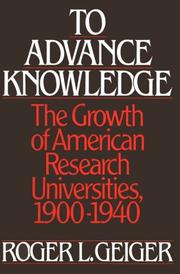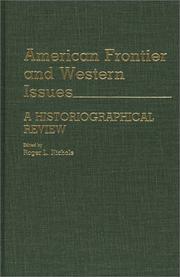| Listing 1 - 5 of 5 |
Sort by
|

ISBN: 0195038037 Year: 1986 Publisher: New York : Oxford University Press,
Abstract | Keywords | Export | Availability | Bookmark
 Loading...
Loading...Choose an application
- Reference Manager
- EndNote
- RefWorks (Direct export to RefWorks)
Research institutes --- Universities and colleges --- Science --- Centres de recherche --- Universités --- Sciences --- History --- Histoire --- Research --- Universities --- 378.4 <73> --- -Science --- -Universities and colleges --- -Colleges --- Degree-granting institutions --- Higher education institutions --- Higher education providers --- Institutions of higher education --- Postsecondary institutions --- Public institutions --- Schools --- Education, Higher --- Natural science --- Science of science --- Institutes, Research --- Research centers --- Think tanks --- Learned institutions and societies --- history. --- Universiteiten--Verenigde Staten van Amerika. VSA. USA --- United States. --- -history. --- 378.4 <73> Universiteiten--Verenigde Staten van Amerika. VSA. USA --- Universités --- history

ISBN: 0313243565 Year: 1986 Volume: 118 Publisher: Westport, Conn. : Greenwood Press,
Abstract | Keywords | Export | Availability | Bookmark
 Loading...
Loading...Choose an application
- Reference Manager
- EndNote
- RefWorks (Direct export to RefWorks)
Frontier and pioneer life --- Vie des pionniers --- Historiography. --- Historiographie --- United States --- West (U.S.) --- Etats-Unis --- Etats-Unis (Ouest) --- Territorial expansion --- Expansion territoriale
Book
Year: 1986 Publisher: Oxford Voltaire foundation
Abstract | Keywords | Export | Availability | Bookmark
 Loading...
Loading...Choose an application
- Reference Manager
- EndNote
- RefWorks (Direct export to RefWorks)
Book
ISBN: 1280439343 9786610439348 1423736850 0195365054 1601295936 Year: 1986 Publisher: New York : Oxford University Press,
Abstract | Keywords | Export | Availability | Bookmark
 Loading...
Loading...Choose an application
- Reference Manager
- EndNote
- RefWorks (Direct export to RefWorks)
American scientific supremacy was built upon the strength of our research universities. This book shows how these universities laid the foundation for the ascendancy of American science in the first half of this century, when they went from being provincial outposts of international science to being the equal of the best European centers of learning. This is a rich social history that tells much not only about the growth of American higher education but also about American intellectual life in general and the politics of scientific research in education. How did research come to be a mojor function of universities? How did universities reconcile the demands of an active research program with their other institutional commitments? To answer these questions, Geiger ranges over a broad spectrum of topics, from the adoption of a selective admissions policy and the development of graduate schools to the continuing vitality of liberal arts colleges within university settings. The book includes fascinating sections on the bizarre attempt to militarize college campuses during World War I and on the backlash of the 1920's, when many major campuses became more concerned with social life than intellectual matters. One remarkable feature of the development of research universities, Geiger points out, was that it was largely accomplished through private resources. Individual philanthropy was responsible for establishing the wealth of the private research universities, and played a key role at several state universities as well. Foundations and corporations were also highly significant in developing the institutions' research capabilities. Geiger describes how each university resolved in its own way the conflict between the research role and other institutional commitments. The major research institutions he deals with are Harvard, Yale, Princeton, MIT, Columbia, Cornell, Pennsylvania, Stanford, the University of Chicago, Johns Hopkins, the California Institute of Technology, and the Universities of Michigan, Illinois, Wisconsin, Minnesota, and California. About the Author: Roger L. Geiger is Associate Research Scientist at the Institution for Social and Policy Studies at Yale University..
Research institutes --- Science --- Universities and colleges --- History. --- History.

ISBN: 0824089480 9780824089481 Year: 1986 Volume: 14 519 Publisher: New York (N.Y.): Garland,
Abstract | Keywords | Export | Availability | Bookmark
 Loading...
Loading...Choose an application
- Reference Manager
- EndNote
- RefWorks (Direct export to RefWorks)
Civil engineering --- Génie civil --- History --- Bibliography --- Histoire --- Bibliographie --- Génie civil --- Civil engineering - History - Bibliography
| Listing 1 - 5 of 5 |
Sort by
|

 Search
Search Feedback
Feedback About UniCat
About UniCat  Help
Help News
News